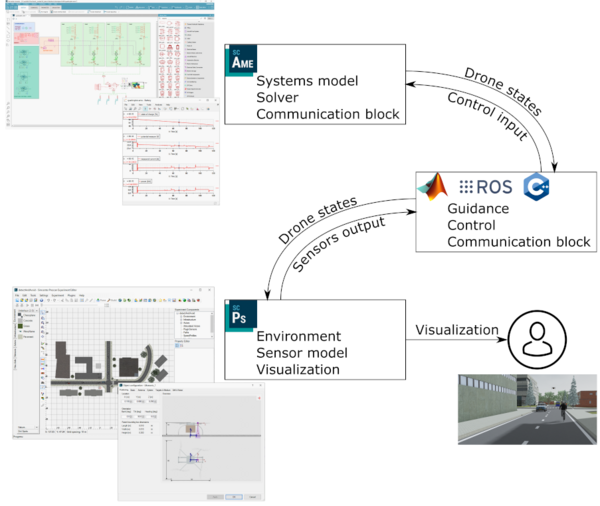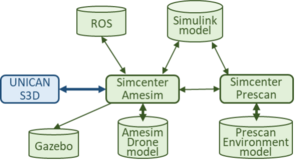WP6-11
Simcenter Amesim
| ID | WP6-11 |
| Contributor | SIEMENS |
| Levels | Tool |
| Require | OS (Windows, Linux) |
| Provide | Analysis of multi-domain systems |
| C4D tooling | N/A |
| TRL | 9 |
| License | Proprietary |
Detailed Description
Siemens’ Simcenter Amesim is a software tool dedicated to modelling and simulation of dynamic and multi-physics systems [1]. In the context of drone design, Amesim allows to create simulation models reproducing the performance of the drone and its subsystems, as well as its ground or flight dynamics. As an example, the tool provides off-the-shelf capabilities to quickly model drones propellers and simulate the torque and thrust generated during flight depending on varying operating conditions (e.g., rotational speed, advancing speed, air density…). Similarly, the performance of batteries, i.e., the open-circuit-voltage dependency on the state of charge, temperature and discharging rate, can be readily simulated. Battery ageing can also be modelled as well as thermal runaway.
Thanks to the multi-physical nature of the tool, different domains concurring to create drones can be integrated together, such as electrical (batteries, motors…), mechanical (propellers, dynamics), thermal (heat dissipation), and control, to simulate the performance of a drone during a given mission. The atmosphere is also represented via the wind, properties (density, temperature…) variation with respect to the altitude. Leveraging the mixed-fidelity modelling approach, the model fidelity evolves along with the design cycles as design decisions are made and more information of the product becomes available.
Simcenter Amesim’s platform offers integration capabilities with third party tools, in particular through the Functional Mock-up Interface [2] protocol. In addition, it supports real time applications, as well as Software-in-the-loop and Hardware-in-the-loop analysis [3].
Contribution and Improvements
Simcenter Amesim provides a high fidelity model of the drone subsystems behavior which have been validated against experimental data (datasheets and flight tests). Several new submodels have been created to assess drone behavior in a windy environment. When testing the Guidance, Navigation and Control (GNC) algorithms, this one sends motor speed setpoints based on the information perceived from the environment via sensors. It is then required to model how the drone perceives its surrounding environment.
Siemens' Simcenter Prescan is a software tool dedicated to the sensor simulation and 3D environment modelling. Starting from digitalized requirements, then a Digital Twin of both the world (including static and dynamic world models, occupant models, etc.) and the sensor will allow the vehicle to make sense of its environment at all times.
A co-simulation framework has been created to easily connect the GNC algorithm to the plant model (Simcenter Amesim) and the environment perception model (Simcenter Prescan). Three variant of this co-simulation framework have been created to connected different technologies of GNC algorithms:
- GNC in Matlab / Simulink for early design stage development (Model in the Loop analysis)
- GNC in C++ for testing the controller code (Software in the Loop analysis)
- GNC as a ROS node for using off-the-shelf autopilot abstraction and perform Hardawre in the Loop analysis
Interoperability with other C4D tools
Simcenter Amesim has an interface feature to perform simulations with Simulink models. The connection with Simcenter Prescan tool, where the environment and sensors are modelled, can be done either via Simulink or directly via TCP/IP. Simcenter Amesim can also be coupled with ROS and Gazebo by using the same technology. Finally, Simcenter Amesim can be integrated with UNICAN S3D. Therefore, the interoperability graph for Simcenter Amesim is the following:
References
[1] Siemens, "Simcenter Amesim," Siemens, [Online]. https://www.plm.automation.siemens.com/global/en/products/simcenter/simcenter-amesim.html [2] https://fmi-standard.org/ [3] Siemens, Simcenter Amesim 2020.2 Reference guide., 2020

